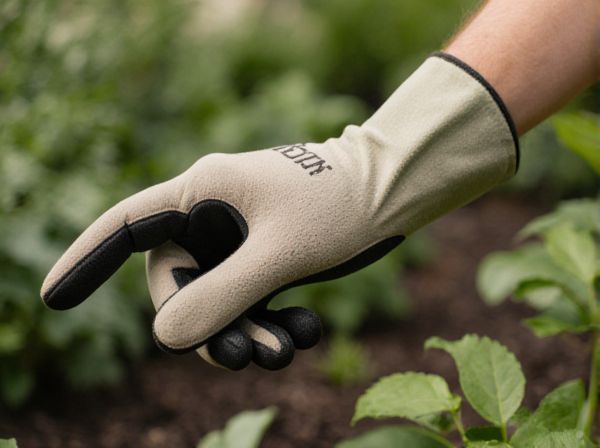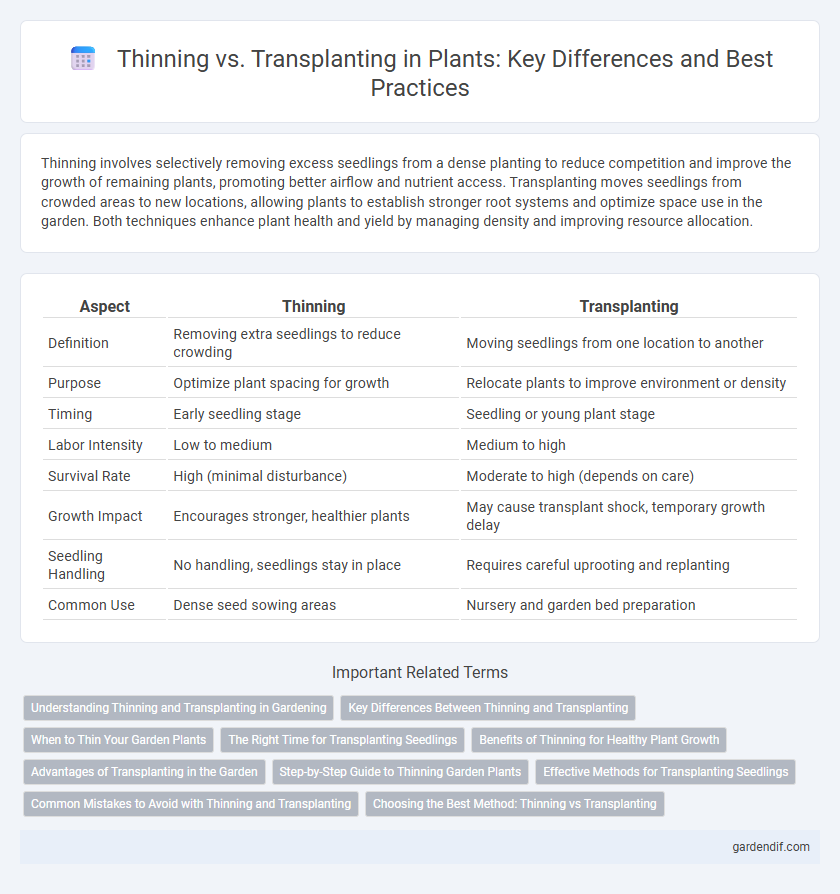
Thinning vs Transplanting Illustration
Thinning involves selectively removing excess seedlings from a dense planting to reduce competition and improve the growth of remaining plants, promoting better airflow and nutrient access. Transplanting moves seedlings from crowded areas to new locations, allowing plants to establish stronger root systems and optimize space use in the garden. Both techniques enhance plant health and yield by managing density and improving resource allocation.
Table of Comparison
| Aspect | Thinning | Transplanting |
|---|---|---|
| Definition | Removing extra seedlings to reduce crowding | Moving seedlings from one location to another |
| Purpose | Optimize plant spacing for growth | Relocate plants to improve environment or density |
| Timing | Early seedling stage | Seedling or young plant stage |
| Labor Intensity | Low to medium | Medium to high |
| Survival Rate | High (minimal disturbance) | Moderate to high (depends on care) |
| Growth Impact | Encourages stronger, healthier plants | May cause transplant shock, temporary growth delay |
| Seedling Handling | No handling, seedlings stay in place | Requires careful uprooting and replanting |
| Common Use | Dense seed sowing areas | Nursery and garden bed preparation |
Understanding Thinning and Transplanting in Gardening
Thinning involves selectively removing overcrowded seedlings to ensure adequate space, light, and nutrients for the remaining plants, promoting healthier growth and higher yields. Transplanting refers to moving young plants from their initial growing location to a more suitable site, allowing gardeners to optimize plant placement for sun exposure, soil quality, and spacing requirements. Both techniques are essential for managing plant density and maximizing garden productivity.
Key Differences Between Thinning and Transplanting
Thinning involves selectively removing weaker seedlings to reduce competition and promote stronger plant growth, while transplanting requires relocating seedlings to a new area for optimal spacing and development. Thinning is typically done within the same planting bed, preserving soil structure, whereas transplanting disturbs the root system and requires careful handling to minimize shock. Both practices enhance crop yield but differ significantly in timing, labor intensity, and impact on plant health.
When to Thin Your Garden Plants
Thin your garden plants when seedlings develop their first true leaves to ensure optimal spacing and prevent overcrowding, which promotes healthier growth and stronger root systems. Early thinning reduces competition for nutrients, water, and light, leading to more vigorous plants and higher yields. Monitor soil moisture and plant density regularly, thinning more frequently in fast-growing species or densely sown crops like carrots and lettuce.
The Right Time for Transplanting Seedlings
The right time for transplanting seedlings is when they have developed at least two to three true leaves and exhibit a strong root system capable of withstanding disturbance. Transplanting too early can shock young plants, while waiting too long may cause root entanglement and stunted growth. Ideal timing varies by species but generally occurs 3-4 weeks after germination, ensuring optimal establishment and increased survival rates.
Benefits of Thinning for Healthy Plant Growth
Thinning promotes healthy plant growth by reducing competition among seedlings for sunlight, water, and nutrients, ensuring stronger and more vigorous plants. It improves air circulation, which decreases the risk of fungal diseases and pest infestations. This technique also helps optimize space, allowing remaining plants to develop robust root systems and maximize overall yield.
Advantages of Transplanting in the Garden
Transplanting offers precise control over plant spacing, which enhances air circulation and reduces disease risk in the garden. It promotes stronger root development by allowing seedlings to establish in optimal soil conditions before being moved. This method also extends the growing season by starting plants indoors, leading to earlier and often higher yields.
Step-by-Step Guide to Thinning Garden Plants
Thinning garden plants involves selectively removing weaker seedlings to reduce overcrowding, improving air circulation and nutrient availability for stronger plants. Begin by identifying the healthiest seedlings spaced at optimal intervals, typically 2 to 3 inches apart for small plants and up to 12 inches for larger varieties. Use scissors to snip excess seedlings at soil level, avoiding disturbance to the roots of remaining plants to promote robust growth.
Effective Methods for Transplanting Seedlings
Transplanting seedlings requires careful root handling and proper timing to minimize shock and maximize survival rates. Effective methods include hardening off plants gradually by exposing them to outdoor conditions, ensuring seedlings have a strong root system, and using appropriate soil amendments to promote root establishment. Maintaining consistent moisture and avoiding deep planting help seedlings adapt quickly to their new environment.
Common Mistakes to Avoid with Thinning and Transplanting
Common mistakes to avoid with thinning include removing too many seedlings at once, which can stunt the growth of remaining plants and reduce overall yield. When transplanting, avoid disturbing roots excessively or planting seedlings too deep, as these errors can lead to transplant shock and poor establishment. Ensuring proper spacing and gentle handling during both thinning and transplanting improves plant health and productivity.
Choosing the Best Method: Thinning vs Transplanting
Thinning involves selectively removing weaker seedlings to allow stronger plants more space and resources, promoting healthier growth directly in the soil. Transplanting requires starting seedlings in a controlled environment before moving them to their permanent location, offering better survival rates and management of plant density. Choosing between thinning and transplanting depends on factors like plant species, garden size, and resource availability, with transplanting typically preferred for sensitive or slow-growing plants to maximize early development.
Thinning vs Transplanting Infographic

 gardendif.com
gardendif.com